Click on images to enlarge
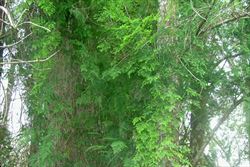
infestation (Photo: Sheldon Navie)
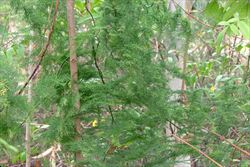
climbing habit (Photo: Sheldon Navie)
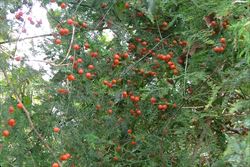
habit in fruit (Photo: Sheldon Navie)
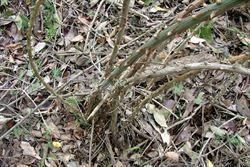
older stems (Photo: Sheldon Navie)

close-up of spines on stem (Photo: Sheldon Navie)
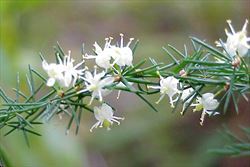
close-up of flowers (Photo: Sheldon Navie)
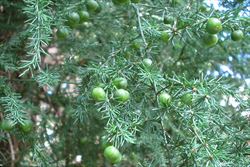
immature fruit (Photo: Sheldon Navie)
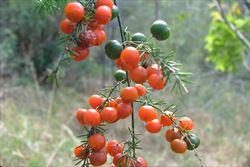
mature fruit (Photo: Sheldon Navie)

close-up of fruit (Photo: Sheldon Navie)
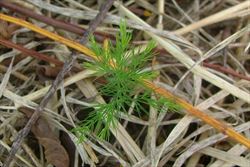
seedling (Photo: Sheldon Navie)
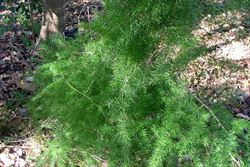
native asparagus fern (Asparagus racemosus) also has a climbing habit (Photo: Sheldon Navie)
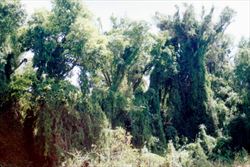
large infestation (Photo: Biosecurity Queensland, QDPI&F)

infestation in the Boondall Wetlands in Brisbane (Photo: Sheldon Navie)
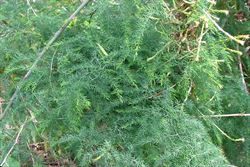
branches with 'leaves' (Photo: Sheldon Navie)
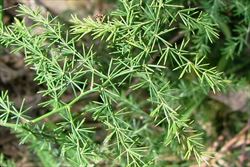
close-up of 'leaves' (Photo: Sheldon Navie)
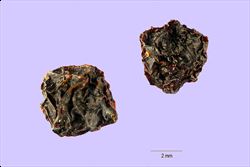
close-up of old fruit (Photo: Tracey Slotta at USDA PLANTS Database)

comparison of the 'leaves' of Asparagus plumosus, on the left, and Aspargaus africanus, on the right (Photo: Sheldon Navie)

the somewhat larger and flattened 'leaves' of Asparagus racemosus (Photo: Sheldon Navie)
Scientific Name
Asparagus africanus Lam.
Synonyms
Protasparagus africanus (Lam.) Oberm.
Family
Asparagaceae (Queensland, New South Wales, the ACT and Western Australia)Liliaceae (Victoria, Tasmania, South Australia and the Northern Territory)
Common Names
African asparagus, asparagus fern, climbing asparagus, climbing asparagus fern, ornamental asparagus, sparrowgrass, wild asparagus
Origin
Native to large parts of eastern and sub-Saharan Africa (i.e. Egypt, Eritrea, Ethiopia, Somalia, Sudan, Kenya, Tanzania, Uganda, Burkina Faso, Gambia, Ghana, Nigeria, Senegal, Malawi, Mozambique, Zimbabwe and South Africa) and the Arabian Peninsula (i.e. Saudi Arabia and Yemen).
Cultivation
Climbing asparagus fern (Asparagus africanus) has been widely cultivated as a garden plant, particularly in eastern Australia.
Naturalised Distribution
This species is becoming widely naturalised in eastern Australia (i.e. in south-eastern and central Queensland and north-eastern New South Wales). It is most common near settlements in south-eastern Queensland, particularly around Brisbane.
Habitat
Primarily a weed of sub-tropical regions, this species invades forests, rainforest margins, open woodlands (particularly those near habitation), urban bushland, and in the vegetation along waterways (i.e. in riparian areas). It is also common in disturbed sites and waste areas, along roadsides, and in parks and gardens.
Habit
A long-lived (i.e. perennial) climber growing up over other vegetation (even over large trees) or a sub-shrub with scrambling stems up to 3 m long.
Distinguishing Features
- a long-lived climber or scrambling sub-shrub with woody and prickly stems.
- its stems bear short side-branches and with numerous tiny 'leaves' that give them a ferny appearance.
- these needle-like 'leaves' (6-15 mm long and only about 0.5 mm wide) are borne in small clusters.
- its tiny white flowers, each with six 'petals', are produced in small clusters along the branchlets.
- its rounded berries (5-6 mm across) turn from green to orange, and become somewhat shrivelled, as they mature.
Stems and Leaves
The stems are hairless (i.e. glabrous) and often bear thorns or spines (2-10 mm long). They usually grow in a twining fashion and bear numerous short spreading branches. The stems of older plants may become quite thick and woody.
The leaves are reduced to minute scales and what appear to be the 'leaves' are actually small stem segments which function as leaves (i.e. cladodes). Several (7-12) of these small bristle-like 'leaves' (6-15 mm long and only about 0.5 mm wide) are produced in a cluster above each scale leaf. They are hairless (i.e. glabrous) and have sharply-pointed tips.
Flowers and Fruit
The flowers are usually produced in small clusters, each containing several flowers, in the forks (i.e. axils) of the scale leaves. They are borne on individual stalks (i.e. pedicels) 5-10 mm long and have three sepals (2.5-4 mm long) and three petals (2.5-4 mm long). The sepals and petals (i.e. perianth segments or tepals) are very similar, whitish in colour, and appear to be six petals. The flowers also have six stamens (2-3.5 mm long), usually with white filaments and yellow anthers. Flowering occurs mainly during spring.
The fruit is a rounded (i.e. globular) berry (5-6 mm across) containing a single seed. These berries are initially green in colour, but turn orange and become somewhat shrivelled as they mature. They may be present throughout most of the year.
Reproduction and Dispersal
This plant reproduces mainly by seed. Its berries are readily eaten and spread by birds and other animals. The seeds may also be spread in dumped garden waste.
Environmental Impact
Climbing asparagus fern (Asparagus africanus) is regarded as an environmental weed in Queensland and New South Wales, and was listed as a priority environmental weed in one Natural Resource Management region. It is a major environmental weed in south-eastern Queensland, and was recently ranked among the top ten most invasive plants in this region. It is also a significant environmental weed in north-eastern New South Wales, particularly in coastal districts north from Lismore. Climbing asparagus fern (Asparagus africanus) has only become naturalised in the last 30 years or so, and is still spreading. It is thought to have the potential to invade rainforests, open woodlands and riparian vegetation throughout the coastal and sub-tropical regions of eastern Australia.
Climbing asparagus fern (Asparagus africanus) scrambles over other vegetation and climbs up to 12 m into the canopies of taller trees. It can often completely smother smaller trees, understorey shrubs and ground layer plants and its fibrous roots form dense mats just below the soil surface, which are thought to interfere with the establishment and survival of seedlings of native species. In south-eastern Queensland this species is most prominent in remnant semi-evergreen vine thickets and brigalow forest communities, particularly in the Marburg and Boonah districts. It also invades gullies and some wetter eucalypt communities.
Legislation
This species is declared under legislation in the following states and territories:
- Queensland: Class 3 - this species is primarily an environmental weed and a pest control notice may be issued for land that is, or is adjacent to, an environmentally significant area (throughout the entire state). It is also illegal to sell a declared plant or its seed in this state.
- Western Australia: Unassessed - this species is declared in other states or territories and is prohibited until assessed via a weed risk assessment (throughout the entire state).
Management
For information on the management of this species see the following resources:
- the Biosecurity Queensland Fact Sheet on this species, which is available online at http://www.dpi.qld.gov.au.
- Section 6 of the Asparagus Weeds Best Practice Management Manual, which is available online at www.weeds.org.au/WoNS/bridalcreeper/docs/Asparagus_Weeds_BPMM-6.pdf.
Similar Species
Climbing asparagus fern (Asparagus africanus) is very similar to another species known as climbing asparagus fern (Asparagus plumosus) and similar to ground asparagus fern (Asparagus aethiopicus 'Sprengeri'), bridal veil (Asparagus declinatus), bridal creeper (Asparagus asparagoides), garden asparagus (Asparagus officinalis), sicklethorn (Asparagus falcatus), Ming asparagus fern (Aspargaus retrofractus) and other asparagus ferns (Asparagus scandens and Asparagus virgatus). These species can be distinguished by the following differences:
- climbing asparagus fern (Asparagus africanus) is a climbing plant with long-lived and thorny main stems. Its 'leaves' (i.e. cladodes) are borne in groups of more than three along the stems, are linear in shape, and are relatively small (6-15 mm long and only about 0.5 mm wide). Its flowers are borne in small several-flowered clusters and its fruit turn orange when mature.
- climbing asparagus fern (Asparagus plumosus) is a climbing plant with long-lived and thornless or slightly thorny main stems. Its 'leaves' (i.e. cladodes) are borne in groups of more than three along the stems, are linear in shape, and are very small (4-7 mm long and only about 0.5 mm wide). Its flowers are borne singly or in pairs and its fruit turn black when mature.
- ground asparagus fern (Asparagus aethiopicus 'Sprengeri') is usually a low-growing or scrambling plant with spreading or drooping branches bearing some small sharp thorns. Its 'leaves' (i.e. cladodes) are borne in groups of one to eight (usually 2-5) along the stems, are linear in shape, and are moderately large (15-25 mm long and 2-3 mm wide). Its flowers are borne in elongated, many-flowered clusters (i.e. racemes) and its fruit turn red when mature.
- bridal veil (Asparagus declinatus) is a creeping or climbing plant with short-lived thornless stems that die back each summer. Its 'leaves' (i.e. cladodes) are borne in groups of three along the stems, are linear in shape, and are relatively small (5-20 mm long and 0.5-1.5 mm wide). Its flowers are borne singly and its fruit turn bluish-grey or whitish in colour when mature.
- bridal creeper (Asparagus asparagoides) is a creeping or climbing plant with short-lived thornless stems that die back each summer. Its 'leaves' (i.e. cladodes) are borne singly along the stems, are oval (i.e. elliptic) in shape, and are relatively large (10-70 mm long and 10-30 mm wide). Its flowers are borne singly or in few-flowered clusters and its fruit turn red when mature.
- garden asparagus (Asparagus officinalis) is an upright plant (up to 2 m tall) with short-lived thornless stems that die back each summer. Its 'leaves' (i.e. cladodes) are borne in groups of one to five along the stems, are linear in shape, and are relatively small (12-25 mm long and 0.5 mm wide). Its flowers are borne singly or in pairs and its fruit turn red when mature.
- sicklethorn (Asparagus falcatus) is a shrubby climbing plant with long-lived and thorny main stems. Its 'leaves' (i.e. cladodes) are borne in groups of three to six along the stems, are elongated in shape, and are quite large (35-125 mm long and 2-5 mm wide). Its flowers are borne in elongated, many-flowered clusters (i.e. racemes) and its fruit turn red or whitish when mature.
- Ming asparagus fern (Aspargaus retrofractus) is shrubby plant with somewhat woody branches bearing some small sharp thorns. Its 'leaves' (i.e. cladodes) are borne in large clusters along the stems, are linear in shape, and are moderately large (12-25 mm long and only about 0.5 mm wide). Its flowers are borne in large rounded clusters and its fruit turn black when mature.
- asparagus fern (Asparagus scandens) is a creeping or climbing plant with short-lived or long-lived thornless stems. Its 'leaves' (i.e. cladodes) are borne in groups of three along the stems, are linear in shape (often slightly curved), and are relatively small (5-15 mm long and 0.5-1.5 mm wide). Its flowers are borne singly or in few-flowered clusters and its fruit turn orange or red when mature.
- asparagus fern (Asparagus virgatus) is an upright plant (up to 1.5 m tall) with short-lived or long-lived thornless stems. Its 'leaves' (i.e. cladodes) are borne in groups of three along the stems, are linear in shape, and are relatively small (6-20 mm long and 0.5-1 mm wide). Its flowers are borne singly and its fruit turn orange when mature.
It is also similar to the native asparagus fern (Asparagus racemosus) which is only found in northern Australia. These two species can be distinguished by the following differences:
- climbing asparagus fern (Asparagus africanus) has 'leaves' (i.e. cladodes) that are linear in shape and relatively small (6-15 mm long and about 0.5 mm wide). Its flowers are borne in small clusters and its fruit (5-6 mm across) turn orange when mature.
- native asparagus fern (Asparagus racemosus ) has 'leaves' (i.e. cladodes) that are linear in shape and relatively large (10-30 mm long and less than 1 mm wide). Its flowers are borne in elongated, many-flowered clusters (i.e. racemes) and its fruit (3-4 mm across) turn red when mature.

